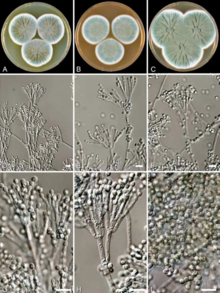Penicillium rubens
| Penicillium rubens | |
|---|---|

| |
| Scientific classification | |
| Domain: | Eukaryota |
| Kingdom: | Fungi |
| Division: | Ascomycota |
| Class: | Eurotiomycetes |
| Order: | Eurotiales |
| Family: | Aspergillaceae |
| Genus: | Penicillium |
| Species: | P. rubens
|
| Binomial name | |
| Penicillium rubens Biourge (1910)
| |
Penicillium rubens is a species of fungus in the genus
History
Belgian microbiologist Philibert Melchior Joseph Ehi Biourge was the first to describe P. rubens in 1923.[6] The medicinal importance was discovered by Alexander Fleming, a physician at St Mary's Hospital, London. In September 1928, Fleming found that one of his bacterial cultures (of Staphylococcus aureus) was contaminated with mould, and that the area around the mould inhibited bacterial growth. He gave the name penicillin for the purported antibacterial substance produced by the mould. After a series of experimental tests, he published his discovery in the June 1929 issue of the British Journal of Experimental Pathology.[7] With the help of his colleague Charles J. La Touche, Fleming identified the fungus as Penicillium rubrum.[1]
But
Whole genome sequence and phylogenetic analysis, particularly using β-tubulin sequences, in 2011 showed that P. notatum is P. rubens, and that P. chrysogenum is a different species.[2][13]
Biology

P. rubens is a common fungus of indoor environment. Along with
Genome
P. rubens has four chromosomes.
The mitochondrial genome consists of 31,790 bp and 17 ORFs.
Uses
P. rubens is the principal source of a class of antibiotics, penicillins. The species produces three such compounds, benzylpenicillin (G), phenoxymethylpenicillin (V) and octanoylpenicillin (K).[24] Penicillin G is the first naturally occurring compound isolated and used as an antibiotic.[25][26][27] It is also the source of cephalosporins.[28]
References
- ^ .
- ^ PMID 22679592.
- S2CID 17070407.
- PMID 25505353.
- PMID 32376967.
- ^ Biourge, P. (1923). "Les moissisures du groupe Penicillium Link". La Cellule. 33: 7–331.
- PMID 11545337.
- .
- JSTOR 3754632.
- S2CID 41843432.
- S2CID 30505910.
- ^ "International Code of Botanical Nomenclature (VIENNA CODE). Appendix IV Nomina specifica conservanda et rejicienda. B. Fungi". International Association of Plant Taxonomy. 2006. Retrieved 17 June 2020.
- PMID 23606767.
- PMID 27316968.
- ^ "Penicillium rubens Biourge ATCC ® 28089™". www.atcc.org. Retrieved 2020-06-17.
- PMID 16560880.
- ^ PMID 32486280.
- ^ S2CID 13542522.
- ^ PMID 18820685.
- PMID 2129535.
- PMID 7597101.
- PMID 24564352.
- PMID 15670713.
- PMID 2166024.
- PMC 3802448.
- PMID 28356901.
- PMID 15522035.
- S2CID 9230950.
